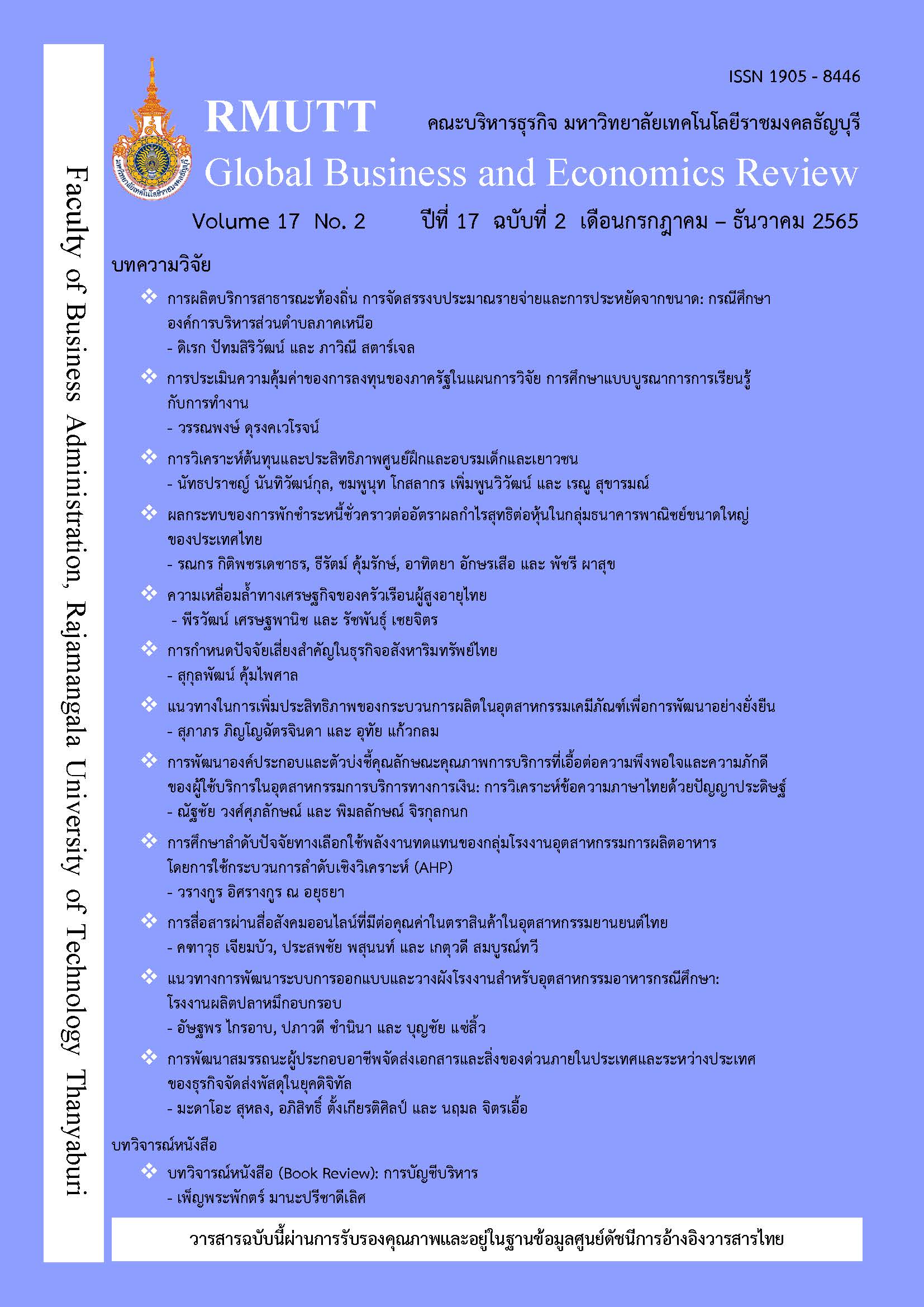DEVELOPMENT OF FACTORS AND INDICATORS OF SERVICE QUALITY AFFECTING TO CUSTOMER SATISFACTION AND LOYALTY IN FINANCIAL SERVICES INDUSTRY: THAI TEXT ANALYTICS WITH ARTIFICIAL INTELLIGENCE
Keywords:
Factors and Indicators, Service Quality, Satisfaction and Loyalty, Financial Services Industry, Thai Text AnalyticsAbstract
The purpose of this research were: 1) to develop artificial intelligence to customers’ opinions Thai text analysis on social media in the financial services industry, and 2) to develop the factors and identifiers of service quality affects to customer satisfaction and loyalty in the financial services industry. Data were comments from commercial bank customer in Thai text on social media during the year 2020 total 8,711 messages, collected by data crawling tool. Model development was carried out using the support vector machine algorithm. Algorithm performance evaluated with F1-Score. The result showed that the F1-Score have accuracy between 75.2 - 76.2 percent. Experts Consensus using an e-Delphi technique consisted of four factors and 21 indicators of service quality. The factor loading was analyzed using the analytical hierarchy process that included 1) process, 2) staff, 3) Branch Service, and 4) Brand Image were 0.32, 0.31, 0.21 and 0.16, respectively.
References
กานดา แผ่วัฒนากุล. (2555). การวิเคราะห์เหมืองข้อเสนอแนะจากบทวิจารณ์รายการโทรทัศน์. (วิทยานิพนธ์ปริญญามหาบัณฑิต, สถาบันบัณฑิตพัฒนบริหารศาสตร์).
ฐิติมา ชูเชิด. (2565). กระแสดิจิทัลเขย่าระบบการเงินโลก ใครปรับตัวอย่างไร?. สืบค้นจาก https://www.bot.or.th/Thai/ResearchAndPublications/DocLib_/Article_22Jan2022-2.pdf
ณัฐกิจ เจนการ และ มหศักดิ์ เกตุฉ่ำ. (2563). การพัฒนาแบบจำลองในการตรวจจับข้อความภาษาไทยที่เป็นการกลั่นแกล้งทางไซเบอร์โดยใช้วิธีซัพพอร์ตเวกเตอร์แมชชีน. วารสารวิทยาศาสตร์ เทคโนโลยีและนวัตกรรม, 1(1), 24-34.
สุมามาลย์ ปานคำ และ เสรี ชัดแช้ม. (2559). การพัฒนาวิธีการวัดฉันทามติของกลุ่มผู้เชี่ยวชาญโดยใช้ทฤษฎีรัฟเซตในเทคนิคเดลฟายแบบอิเล็กทรอนิกส์. วิทยาการวิจัยและวิทยาการปัญญา, 14(2), 87-101.
สำนักการค้าบริการและการลงทุน. (2563). บริการด้านการเงิน ภาคการธนาคารและบริการด้านการเงินอื่น ๆ. สืบค้นจาก https://api.dtn.go.th/files/v3/5e995890ef4140e1ab73d209/download
Acharjya, D. P. (2016). A survey on big data analytics: challenges, open research issues and tools. International Journal of Advanced Computer Science and Applications, 7(2), 511-518.
Dam, S. M., & Dam, T. C. (2021). Relationships between service quality, brand image, customer satisfaction, and customer loyalty. Journal of Asian Finance, Economics and Business, 8(3), 585-593.
Dewindaru, D., Syukri, A., Maryono, R. A., & Yunus, U. (2022). Millennial customer response on social-media marketing effort, brand image, and brand awareness of a conventional bank in Indonesia. Linguistics and Culture Review, 6(S1), 397-412.
Gayathri, S., & Rekhapriyadharshini. (2022). The mediating effect of customer satisfaction on the relationship between service quality and customer loyalty in digital banking. Journal of Contemporary Issues in Business and Government, 28(1), 20-31.
Goepel, K. D. (2013). Implementing the Analytic Hierarchy Process as a Standard Method for Multi-Criteria Decision Making in Corporate Enterprises - A New AHP Excel Template with Multiple Inputs. In Proceedings of the International Symposium on the Analytic Hierarchy Process, Kuala Lumpur, 2013 (pp. 1-10). Kuala Lumpur: International Islamic University Malaysia.
Hammoud, J., Bizri, R. M., & El Baba, I. (2018). the impact of e-banking service quality on customer satisfaction: evidence from the lebanese banking sector, SAGE Open, 4, 1-12.
Islam, R., Ahmed, S., Rahman, M., & Al Asheq, A. (2021). Determinants of service quality and its effect on customer satisfaction and loyalty: an empirical study of private banking sector. The TQM Journal, 33(6), 1163-1182.
Jurka, T. P., Collingwood, L., Boydstun, A. E., Grossman, E., & van Atteveldt, W. (2013). RTextTools: a supervised learning package for text classification. The R Journal, 5(1), 1-7.
Kohavi, R. (1995). A study of cross-validation and bootstrap for accuracy estimation and model selection. In H. Dalianis (Ed), Evaluation Metrics and Evaluation (pp 45-53). Springer Cham. Retrieved from https://doi.org/10.1007/978-3-319-78503-5_6
Komiljonovich, B. S. (2021). Opportunities to increase the effectiveness of marketing activities in the enterprise. Academic Journal of Digital Economics and Stability, 6, 168-175.
Kotler, P., Kartajaya H., & Setiawan, I. (2017). Marketing 4.0: moving from traditional to digital. New Jersey: John Wiley & Sons.
MacMillan, T. T. (1971). The delphi technique. In Paper presented at the annual meeting of the california junior colleges associations committee on research and development (pp. 1-24). Monterey: California Malhotra.
Nazaritehrani, A., & Mashali, B. (2020). Development of E-banking channels and market share in developing countries. Financial Innovation, 6(12), 1-19.
Parasuraman, A., Zeitjaml, V. A., & Berry, L. L. (1985). A concept model of service quality and its implications for future research. Journal of Marketing, 49(3), 41-50.
Parasuraman, A., Zeitjaml, V. A., & Berry, L. L. (1988). SERVQUAL: a multiple item scale for measuring consumer perception of service quality. Journal of Retailing, 64(1), 12-37.
Qaiser. S., & Ali, R. (2018). Text mining: use of TF-IDF to examine the relevance of words to documents. International Journal of Computer Applications, 181(1), 25-29.
Raza, S. A., & Umer, A. (2020). Internet banking service quality, e-customer satisfaction and loyalty: the modified e-SERVQUAL model. The TQM Journal, 32(6), 1443-1466.
Saaty, T. L., & Vargas, L. G., (2012). Models, methods, concepts & applications of the analytic hierarchy process (2nd ed). New York: Springer Science Business Media.
Salim, M., & Rodhiah. (2022). The effect of perceived quality, customer satisfaction, corporate image, customer experience on customer loyalty. Budapest International Research and Critics Institute-Journal, 5(1), 2615-1715.
Satheesh, M. K., & Nagaraj, S. (2021). Applications of artificial intelligence on customer experience and service quality of the banking sector. International Management Review, 17(1), 9-17.
Teeroovengadum, V. (2022). Service quality dimensions as predictors of customer satisfaction and loyalty in the banking industry: moderating effects of gender. European Business Review, 34(1), 1-19.
Vashishth, M. (2014). Role of IT in HRM: opportunities and challenges. Indian Journal of Research, 3(4), 159-160.
Wenchao, M., Lian-chen, L., & Ting, D. (2009). A modified approach to keyword extraction based on word-similarity. 2009 IEEE International Conference on Intelligent Computing and Intelligent Systems, 388-392, doi: 10.1109/ICICISYS.2009.5358135.
Wirtz, J., & Lovelock, C. (2018). Essentials of Services Marketing (3rd ed). Harlow: Pearson.
Downloads
Published
How to Cite
Issue
Section
License
Copyright (c) 2022 Nattachai Wongsupaluk, Pimolluck Jirakunkanok

This work is licensed under a Creative Commons Attribution-NonCommercial-NoDerivatives 4.0 International License.
The articles published in this journal are the intellectual property of their respective authors.
The views and opinions expressed in each article are solely those of the individual authors and do not reflect the positions of Rajamangala University of Technology Thanyaburi or any of its faculty members. All components and content of each article are the sole responsibility of the respective authors. In the event of any errors, the authors shall bear full responsibility for their own work.








